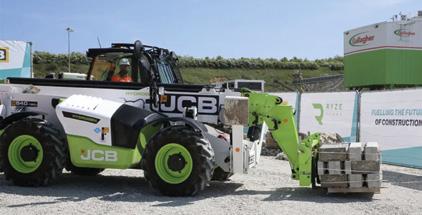
4 minute read
Kent plays host to landmark hydrogen construction plant trial

Kent-based Gallagher Group recently hosted a landmark hydrogen-powered plant trial at their Hermitage Quarry as part of their journey to Net Zero by 2050, in collaboration with the Lower Thames Crossing (LTC) project, JCB, and Ryze Power.
The trial represents a major step forward for the Lower Thames Crossing’s ambition to eliminate diesel use from its construction sites by 2027, and Gallagher Group provided the setting for LTC’s first successful trial of low-carbon, hydrogen combustion-powered machinery – a JCB 540-180H Loadall.
This cutting-edge machine replaced a traditional diesel-powered Loadall during masonry operations at Hermitage Quarry. Not only did it operate safely and effectively, but it also delivered zero tailpipe emissions and demonstrated a potential CO2 saving of around 205kg per machine, per week, compared with a conventional diesel-powered machine, providing clear evidence of the potential for hydrogen to decarbonize heavy construction machinery. The trial at Hermitage Quarry supports the Lower Thames Crossing’s broader goal to reduce construction carbon by 70%, making it the UK’s greenest road project. Set to begin construction as early as 2026, the project will be the first in the UK to use hydrogen at such a large scale to power heavy plant machinery, alongside electric vehicles.
Gallagher is committed to reducing emissions across all aspects of their operations and see the adoption of hydrogen power as a vital step towards delivering low-carbon construction solutions that are both practical and scalable.
Sean Connor, managing director of Gallagher Aggregates Ltd, said: ‘As part of our own journey to Net Zero and in keeping with our drive for low-carbon, sustainable construction solutions, Gallagher were delighted to host and carry out this hydrogen trial in partnership with JCB, Lower Thames Crossing, and Ryze Power. As an award-winning Net Zero Trailblazer, we are proud to be at the forefront of adopting new innovative solutions.’
Preserving vital conservation skills for future generations
Baxall undertook a complex, 60-week conservation and modernisation project to convert at Tonbridge School’s Grade II-listed Cawthorn Building (featured on the front cover) from a former lecture theatre into a modern staff facility.
Originally built as a chapel in the 1850s, the building underwent extensive refurbishment to preserve its architectural heritage while integrating modern amenities including showers, WCs and a café area.
Working within a live school environment in a sensitive conservation area, the project necessitated close collaboration with heritage officers, the local authority and the school. Key works included the removal and reconstruction of delicate, Gothic-style stained glass windows by specialist contractor Easthope Studios, using traditional methods to conserve the original artwork. The building’s exterior was cleaned using a high-temperature steam system, and ornate internal features including the red Devonshire marble and carved tulipwood mouldings were meticulously restored. baxallconstruction.co.uk
Modern upgrades encompassed installation of new M&E services, drainage and a mezzanine floor structure, with significant structural interventions including diamond drilling through 1.5m thick walls. Unexpected discoveries (such as the original tiled floor) were carefully preserved and transformed into a feature display. Safety and logistics were carefully managed from start to finish due to the site’s constrained location and public interfaces. Despite numerous challenges including working around the school’s busy events programme and exam periods, Baxall successfully delivered the project two weeks ahead of schedule. The result is a state-of-the-art facility that remains true to its heritage, showcases exceptional craftsmanship and sustains local specialist trades, preserving vital conservation skills for future generations.
Matt Palmer, executive director of Lower Thames Crossing, said: ‘The Lower Thames Crossing is a Pathfinder project, designed to be the greenest road ever built in Britain. At the heart of these plans is the use of clean low-carbon hydrogen power, and by using it on such a large scale to power our heavy construction machinery that is traditionally hard to electrify, we can significantly reduce our carbon footprint, accelerate the construction industry’s shift away from diesel, and help kick-start the creation of a hydrogen ecosystem in the Thames Estuary.’
Gallagher Group’s involvement in the trial supports the transition to cleaner construction methods, but also contributes to the growth of a hydrogen ecosystem in the Thames Estuary, an initiative expected to be worth £3.8 billion and create 9,000 skilled jobs by 2035. www.gallagher-group.co.uk
Grow Your Business with Buildbeta: The Smart Construction
Platform
Are you a contractor, tradesperson, supplier, or financier looking to connect with real projects and real clients?
Buildbeta is your digital ally to more work, faster communication, and seamless project management.
Why Join Buildbeta?
• Lead Generation Made Easy: Get matched with clients needing your services, from home repairs to improvements to full new builds.
• Transparent Collaborations: Directly connect with suppliers and tradespersons for successful project outcomes.
• Live Project Updates: Stay informed at every project phase with real-time updates.
Boost Visibility and get discovered by clients who need your skills or services, right now by scanning the qr code …. downloadable on both Apple and Google stores. Or contact us at: www.buildbeta.co.uk • 02030515409
Buildbeta®️ a trading name of

As HR professionals working closely with construction firms across Kent and the South East, we’ve seen firsthand the challenges and opportunities the industry faces in becoming more inclusive.
While the sector has made strides in modernising its practices, it remains one of the most male-dominated industries in the country. This imbalance is not just a diversity issue; it’s a cultural one, and the creation of work environments free from the threat of sexual harassment remains a priority for many firms. True inclusivity, though, must also embrace other dimensions and provide a fully inclusive working environment.
Demolishing barriers
Despite efforts to attract more women into construction, women make up just 15% of the workforce, with even fewer in senior or site-based roles. This underrepresentation is not just a numbers issue—it reflects deeper cultural and structural barriers.
Construction sites have long been associated with a ‘lads’ culture’—banter, bravado, and, too often, boundary-crossing behaviour. A 2022 Randstad report found that nearly 45% of women in construction had experienced or witnessed harassment, with two-thirds reporting gender discrimination.
Many women also report facing gender bias, exclusion from informal networks, and a lack of visible role models, contributing to high attrition rates and a lack of diversity in leadership.
Shifting the legal landscape
With the introduction of the Worker Protection (Amendment of Equality Act 2010) Act in 2024, employers now have a statutory duty to take ‘reasonable steps’ to prevent sexual harassment and this may well be amended in future to a test whereby ‘all reasonable steps’









